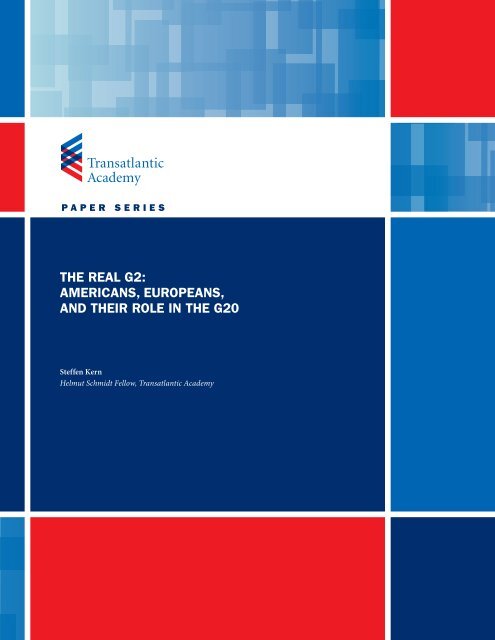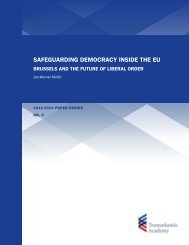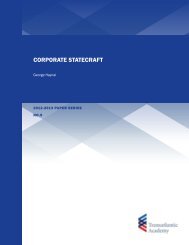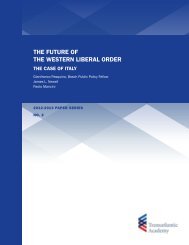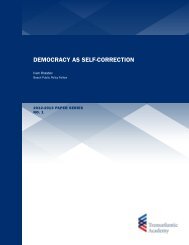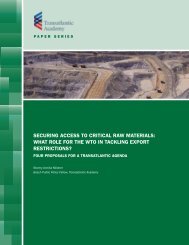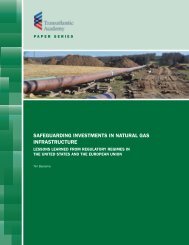the real g2: americans, europeans, and their role in the g20
the real g2: americans, europeans, and their role in the g20
the real g2: americans, europeans, and their role in the g20
- No tags were found...
Create successful ePaper yourself
Turn your PDF publications into a flip-book with our unique Google optimized e-Paper software.
© 2011 Transatlantic Academy. All rights reserved.No part of this publication may be reproduced or transmitted <strong>in</strong> any form or by any means without permission<strong>in</strong> writ<strong>in</strong>g from <strong>the</strong> Transatlantic Academy. Please direct <strong>in</strong>quiries to:Transatlantic Academy1744 R Street, NWWash<strong>in</strong>gton, DC 20009T 1 202 745 3886F 1 202 265 1662E TA@gmfus.orgThis publication can be downloaded for free at http://www.transatlanticacademy.org.Transatlantic Academy Paper SeriesThe Transatlantic Academy Paper Series presents research on a variety of transatlantic topics by staff, fellows, <strong>and</strong>partners of <strong>the</strong> Transatlantic Academy. The views expressed here are those of <strong>the</strong> author <strong>and</strong> do not necessarilyrepresent <strong>the</strong> view of <strong>the</strong> Transatlantic Academy. Comments from readers are welcome; reply to <strong>the</strong> mail<strong>in</strong>g addressabove or by e-mail to TA@gmfus.org.About <strong>the</strong> Transatlantic AcademyFounded by <strong>the</strong> German Marshall Fund of <strong>the</strong> United States (GMF), <strong>the</strong> ZEIT-Stiftung Ebel<strong>in</strong> und GerdBucerius, <strong>the</strong> Robert Bosch Stiftung, <strong>and</strong> <strong>the</strong> Lynde <strong>and</strong> Harry Bradley Foundation, <strong>the</strong> Transatlantic Academyserves as a forum for a select group of scholars from both sides of <strong>the</strong> Atlantic <strong>and</strong> from different academic <strong>and</strong>policy discipl<strong>in</strong>es to exam<strong>in</strong>e a s<strong>in</strong>gle set of issues. Work<strong>in</strong>g toge<strong>the</strong>r from a transatlantic <strong>and</strong> <strong>in</strong>terdiscipl<strong>in</strong>aryperspective, Academy fellows use research, publications, <strong>and</strong> ideas to make policy-relevant contributions topolicy debates fac<strong>in</strong>g <strong>the</strong> transatlantic community. In addition, <strong>the</strong> Academy has received early support from<strong>the</strong> Transatlantic Program of <strong>the</strong> Government of <strong>the</strong> Federal Republic of Germany through funds of <strong>the</strong> EuropeanRecovery Program (ERP) of <strong>the</strong> Federal M<strong>in</strong>istry of Economics <strong>and</strong> Technology. The Compagnia di SanPaolo jo<strong>in</strong>ed as a f<strong>in</strong>ancial partner <strong>in</strong> May 2009.Chosen from <strong>the</strong> field of economics, Transatlantic Academy Helmut Schmidt Fellows are <strong>in</strong> residence at <strong>the</strong>Transatlantic Academy for up to five months. The Helmut Schmidt Fellowship is made possible through agenerous grant from ZEIT-Stiftung Ebel<strong>in</strong> und Gerd Bucerius <strong>in</strong> honor of <strong>the</strong> 90th birthday of former GermanChancellor Helmut Schmidt.
AbstractGlobal economic governance is <strong>in</strong> <strong>the</strong> process ofmak<strong>in</strong>g a quantum leap. Hopes regard<strong>in</strong>g <strong>the</strong> G20process as <strong>the</strong> new global nucleus of political <strong>and</strong>economic governance are strong. But <strong>the</strong> <strong>real</strong>ityof <strong>in</strong>ternational f<strong>in</strong>ancial market diplomacy is aharsh one. Reach<strong>in</strong>g consensus among <strong>the</strong> G20participants on f<strong>in</strong>ancial market governance hasproved a challeng<strong>in</strong>g task. This article argues that<strong>the</strong> United States <strong>and</strong> <strong>the</strong> European Union are <strong>the</strong>problem – <strong>and</strong> its solution.Recent disagreements over capital <strong>and</strong> liquidityrequirements, <strong>the</strong> organization of over-<strong>the</strong>counter(OTC) derivatives markets, <strong>the</strong> treatmentof alternative <strong>in</strong>vestments, <strong>and</strong> <strong>the</strong> h<strong>and</strong>l<strong>in</strong>g ofsystemically important f<strong>in</strong>ancial <strong>in</strong>stitutions areonly a few examples of <strong>the</strong> low po<strong>in</strong>t transatlanticf<strong>in</strong>ancial market diplomacy has reached. At <strong>the</strong>same time, only <strong>the</strong> United States <strong>and</strong> <strong>the</strong> EUcan provide <strong>the</strong> impetus <strong>the</strong> G20 process needs.This requires that <strong>the</strong>y first <strong>and</strong> foremost arriveat jo<strong>in</strong>t policy positions between <strong>the</strong>mselves. Inpractice, this necessitates concrete cooperation on<strong>the</strong> schedul<strong>in</strong>g, design, <strong>and</strong> details of regulation.This would optimally <strong>in</strong>clude ex ante bilateralconsultations on all new policy measures as well asa close coord<strong>in</strong>ation of policy positions discussed<strong>in</strong> <strong>the</strong> G20. In <strong>the</strong> f<strong>in</strong>al analysis, however, <strong>the</strong>credibility of Americans <strong>and</strong> Europeans will depend<strong>in</strong> <strong>the</strong> long run on <strong>the</strong>ir ability to achieve a more<strong>in</strong>tegrated f<strong>in</strong>ancial market at <strong>the</strong> transatlantic level.These are very ambitious objectives, but <strong>the</strong>irbenefits would be substantial <strong>and</strong> <strong>real</strong>. The UnitedStates <strong>and</strong> <strong>the</strong> EU should <strong>in</strong>tensify <strong>the</strong>ir policycooperation <strong>and</strong> encourage <strong>the</strong>ir G20 partners tostrive for more effective global coord<strong>in</strong>ation off<strong>in</strong>ancial market policies.The Real G2: Americans, Europeans,<strong>and</strong> <strong>the</strong>ir Role <strong>in</strong> <strong>the</strong> G201
IntroductionGlobal economic governance is <strong>in</strong> <strong>the</strong> processof mak<strong>in</strong>g a quantum leap. Hopes regard<strong>in</strong>g<strong>the</strong> G20 process as <strong>the</strong> new global nucleus ofpolitical <strong>and</strong> economic governance are strong. Inf<strong>in</strong>ancial market matters, this high-level processis supported by <strong>in</strong>ternational organizations, suchas <strong>the</strong> International Monetary Fund (IMF), <strong>the</strong>F<strong>in</strong>ancial Stability Board (FSB), or <strong>the</strong> InternationalOrganization of Securities Commissions(IOSCO), whose work holds out <strong>the</strong> prospect ofan <strong>in</strong>ternationally coord<strong>in</strong>ated approach to <strong>the</strong> keyregulatory challenges <strong>in</strong> <strong>the</strong> world’s <strong>in</strong>creas<strong>in</strong>gly<strong>in</strong>tertw<strong>in</strong>ed f<strong>in</strong>ancial markets.Expectations are high, <strong>and</strong> <strong>the</strong> urgency of closer<strong>in</strong>ternational cooperation after <strong>the</strong> f<strong>in</strong>ancial crisis ishigher still. But <strong>the</strong> <strong>real</strong>ity of <strong>in</strong>ternational f<strong>in</strong>ancialmarket diplomacy is a harsh one. Two years after<strong>the</strong> first G20 meet<strong>in</strong>g at <strong>the</strong> pr<strong>in</strong>cipal level <strong>in</strong>Wash<strong>in</strong>gton <strong>in</strong> November 2008, optimism about<strong>the</strong> scope for global solutions has given way tosober <strong>real</strong>ism. Reach<strong>in</strong>g consensus among <strong>the</strong> G20participants on f<strong>in</strong>ancial market governance – beit on gr<strong>and</strong> design or specific detail – has proved achalleng<strong>in</strong>g task, even at a time when <strong>the</strong> memoryof <strong>the</strong> f<strong>in</strong>ancial crisis <strong>and</strong> <strong>the</strong> perceived “[need for]reforms <strong>in</strong> <strong>the</strong> world’s f<strong>in</strong>ancial systems” 1 is stillfresh.The United States <strong>and</strong> <strong>the</strong> European Union are<strong>the</strong> problem – <strong>and</strong> its solution. While <strong>the</strong> globaleconomy is undergo<strong>in</strong>g tectonic changes, <strong>and</strong>its future is widely expected to be shaped by <strong>the</strong>United States <strong>and</strong> Ch<strong>in</strong>a – often referred to as <strong>the</strong>G2 – this article argues that it is <strong>the</strong> United States<strong>and</strong> <strong>the</strong> EU who need to provide <strong>the</strong> impetus <strong>the</strong>G20 process needs. Only <strong>the</strong>y can drive globalf<strong>in</strong>ancial market reform. O<strong>the</strong>rwise, <strong>the</strong> visionof establish<strong>in</strong>g <strong>the</strong> G20 as an effective forum for<strong>in</strong>ternational economic policy coord<strong>in</strong>ation mayfail.The G20 as a Forum of InternationalF<strong>in</strong>ancial Market Policy Coord<strong>in</strong>ationIf successful, <strong>the</strong> G20 may enter history books asone of <strong>the</strong> most important <strong>in</strong>stitutional <strong>in</strong>novations<strong>in</strong> post-cold war global politics. While <strong>the</strong> <strong>in</strong>itialcrisis reaction held out <strong>the</strong> prospect of a new eraof <strong>in</strong>ternational high-level cooperation, however, anumber of political challenges have surfaced s<strong>in</strong>ceits <strong>in</strong>ception, rooted <strong>in</strong> <strong>the</strong> design of <strong>the</strong> processbut also <strong>in</strong> <strong>the</strong> diverg<strong>in</strong>g <strong>in</strong>terests among <strong>the</strong> majorparticipants.The rationale of <strong>the</strong> G20 process was spelledout clearly at <strong>the</strong> first high-level meet<strong>in</strong>g <strong>in</strong>November 2008, <strong>and</strong> has been greeted by manypolitical, academic, <strong>and</strong> bus<strong>in</strong>ess commentatorsas an important, if not overdue, step. Twoimportant objectives can be identified. One is <strong>the</strong><strong>in</strong>tensification of policy cooperation. In <strong>the</strong> areaof f<strong>in</strong>ancial market policy, <strong>the</strong> G20 participantsdecided to “[...] enhance [...] cooperation <strong>and</strong>work toge<strong>the</strong>r to [...] achieve needed reforms <strong>in</strong><strong>the</strong> world’s f<strong>in</strong>ancial systems.” In particular, <strong>the</strong>G20 recognized that “[...] f<strong>in</strong>ancial markets areglobal <strong>in</strong> scope [<strong>and</strong>] <strong>in</strong>tensified <strong>in</strong>ternationalcooperation among regulators <strong>and</strong> streng<strong>the</strong>n<strong>in</strong>gof <strong>in</strong>ternational st<strong>and</strong>ards [...] <strong>and</strong> <strong>the</strong>ir consistentimplementation is necessary to protect aga<strong>in</strong>stadverse cross-border, regional, <strong>and</strong> globaldevelopments affect<strong>in</strong>g <strong>in</strong>ternational f<strong>in</strong>ancialstability.” 2Second, it was agreed to open up <strong>the</strong> high-leveldialogue <strong>and</strong> enhance <strong>the</strong> circle of decision-makersto <strong>in</strong>clude key emerg<strong>in</strong>g economies. Extend<strong>in</strong>g <strong>the</strong>Two years after<strong>the</strong> first G20meet<strong>in</strong>g optimismhas given way tosober <strong>real</strong>ism. TheU.S. <strong>and</strong> <strong>the</strong> EUare <strong>the</strong> problem— <strong>and</strong> its solution.1G20 Meet<strong>in</strong>g, November 15, 2008, f<strong>in</strong>al communiqué:“Wash<strong>in</strong>gton Declaration – Summit on f<strong>in</strong>ancial markets <strong>and</strong><strong>the</strong> world economy.”2G20 Meet<strong>in</strong>g, November 15, 2008, f<strong>in</strong>al communiqué:“Wash<strong>in</strong>gton Declaration – Summit on f<strong>in</strong>ancial markets <strong>and</strong><strong>the</strong> world economy.”The Real G2: Americans, Europeans,<strong>and</strong> <strong>the</strong>ir Role <strong>in</strong> <strong>the</strong> G203
Jo<strong>in</strong>t action onf<strong>in</strong>ancial marketreform will leadto superior policyoutcomes. It’ssuccess h<strong>in</strong>ges on<strong>the</strong> U.S. <strong>and</strong> <strong>the</strong>EU solv<strong>in</strong>g <strong>the</strong>irbilateral issues<strong>and</strong> forg<strong>in</strong>g aheadwith <strong>in</strong>ternationalcooperation.forum of policy coord<strong>in</strong>ation from <strong>the</strong> traditionaladvanced nations of <strong>the</strong> G7 to <strong>the</strong> 20 mostimportant economies promised a more effectiveh<strong>and</strong>l<strong>in</strong>g of <strong>the</strong> 2008 f<strong>in</strong>ancial crisis <strong>and</strong> a moresusta<strong>in</strong>able policy framework for navigat<strong>in</strong>g <strong>the</strong>post-crisis environment. It did this by <strong>in</strong>vit<strong>in</strong>g fastdevelop<strong>in</strong>gnations such as Ch<strong>in</strong>a, India, <strong>and</strong> Brazil,which enjoy a grow<strong>in</strong>g share <strong>in</strong> global trade <strong>and</strong>output <strong>and</strong> <strong>in</strong>creas<strong>in</strong>g stakes <strong>in</strong> global production<strong>and</strong> asset ownership, as well as formidable f<strong>in</strong>ancialreserves. Includ<strong>in</strong>g key emerg<strong>in</strong>g economies <strong>in</strong>global economic policy coord<strong>in</strong>ation has beenpraised widely as a major leap forward for globalgovernance.The potential benefits of closer cooperation amonga larger number of key players are substantial.In f<strong>in</strong>ancial market policy, a jo<strong>in</strong>t approach toregulation <strong>and</strong> supervision promises a more levelplay<strong>in</strong>g field <strong>in</strong> terms of regulation <strong>and</strong> a lowerrisk of regulatory arbitrage by market participants.By establish<strong>in</strong>g high-quality rules across <strong>the</strong> G20,<strong>the</strong> overall level of f<strong>in</strong>ancial market oversightcould be raised substantially. Closer cooperationamong supervisory authorities may contribute toa more effective h<strong>and</strong>l<strong>in</strong>g of cross-border risksfor <strong>in</strong>ternational capital flows <strong>and</strong> transnationaloperations of f<strong>in</strong>ancial firms. In o<strong>the</strong>r words, jo<strong>in</strong>taction may result <strong>in</strong> superior policy outcomes,as <strong>the</strong> logic of what <strong>the</strong>orists refer to as collectiveaction also applies to f<strong>in</strong>ancial market diplomacy. 3But so do <strong>the</strong> problems associated with collectiveaction. Thus, <strong>the</strong> likelihood of reach<strong>in</strong>g agreementamong <strong>the</strong> participants <strong>in</strong> <strong>the</strong> policy processdecl<strong>in</strong>es with <strong>the</strong>ir number <strong>and</strong> with a ris<strong>in</strong>gheterogeneity of <strong>the</strong>ir <strong>in</strong>terests. The transitionfrom G7 to <strong>the</strong> G20 has added to both. In addition,<strong>the</strong> chances of f<strong>in</strong>d<strong>in</strong>g jo<strong>in</strong>t solutions rise with3Masson (2009) provides a comprehensive <strong>the</strong>oretical analysisof <strong>the</strong> dynamics beh<strong>in</strong>d <strong>in</strong>ternational cooperation <strong>in</strong> f<strong>in</strong>ancialmarket regulation.<strong>the</strong> expected costs of failure to do so, 4 <strong>and</strong> <strong>the</strong>unexpectedly quick economic recovery after<strong>the</strong> crisis <strong>in</strong> many parts of <strong>the</strong> world has clearlydim<strong>in</strong>ished <strong>the</strong> sense of urgency perceived <strong>in</strong> <strong>the</strong>context of f<strong>in</strong>ancial market reform. Cooperationmay get fur<strong>the</strong>r aggravated by <strong>the</strong> multitude ofnegotiat<strong>in</strong>g bodies <strong>in</strong>volved, especially if <strong>the</strong>irmembership varies as is <strong>the</strong> case between <strong>the</strong> G20,<strong>the</strong> IMF, <strong>the</strong> FSB, IOSCO or <strong>the</strong> Basel Committee. 5F<strong>in</strong>ally, <strong>the</strong> question of <strong>the</strong> right scope of <strong>the</strong>G20 rema<strong>in</strong>s a latent issue. Depend<strong>in</strong>g on <strong>the</strong>perspective <strong>the</strong>y have, critics have claimed that <strong>the</strong>Group may be ei<strong>the</strong>r too large or too small, <strong>and</strong>that <strong>the</strong> range of political issues on <strong>the</strong> G20 agendawas too extensive or too limited. 6Theory, however, tells us ano<strong>the</strong>r important storyabout <strong>in</strong>ternational negotiations: Their successcritically h<strong>in</strong>ges on group dynamics – atomistic,self-<strong>in</strong>terested countries are less likely to reachagreement than a limited number of oligopolisticplayers, <strong>and</strong> <strong>the</strong> likelihood of jo<strong>in</strong>t solutions vitallydepends on one or more large countries forg<strong>in</strong>gahead with <strong>in</strong>ternational cooperation. 7This br<strong>in</strong>gs us to <strong>the</strong> United States <strong>and</strong> <strong>the</strong> EU. If<strong>the</strong>ory — let alone historical experience — is rightabout <strong>the</strong> central importance of a small number ofkey drivers <strong>in</strong> <strong>in</strong>tergovernmental processes, <strong>the</strong>n<strong>the</strong> United States <strong>and</strong> <strong>the</strong> EU <strong>in</strong>tuitively qualifyas important promoters of jo<strong>in</strong>t G20 solutions.Judg<strong>in</strong>g by <strong>the</strong>ir economic <strong>and</strong> f<strong>in</strong>ancial weight,<strong>the</strong>y should <strong>in</strong>deed be <strong>the</strong> driv<strong>in</strong>g force beh<strong>in</strong>dglobal policy coord<strong>in</strong>ation, especially <strong>in</strong> <strong>the</strong> area off<strong>in</strong>ancial market regulation.4Masson (2009), pp. 18-19.5Weber (2007), p. 103 <strong>and</strong> Bradlow (2010).6Bradlow (2010), p. 12.7Masson (2009), p. 17.4Transatlantic Academy
The United States <strong>and</strong> <strong>the</strong> EU:Global Centres of F<strong>in</strong>ance <strong>and</strong> RegulationThe still central <strong>role</strong> of America <strong>and</strong> Europe <strong>in</strong>global f<strong>in</strong>ance is impressive. In bank<strong>in</strong>g, well overtwo-thirds of global assets rema<strong>in</strong> concentrated<strong>in</strong> f<strong>in</strong>ancial centres <strong>in</strong> <strong>the</strong> United States <strong>and</strong> <strong>the</strong>EU. Toge<strong>the</strong>r, <strong>the</strong>y capture more than threequartersof <strong>the</strong> global revenue pool of <strong>in</strong>vestmentbank<strong>in</strong>g services. On stock exchanges, <strong>the</strong> shareof <strong>the</strong> United States <strong>and</strong> <strong>the</strong> EU <strong>in</strong> global marketcapitalization rema<strong>in</strong>s dom<strong>in</strong>ant at more than 50percent of <strong>the</strong> total, <strong>and</strong> <strong>the</strong> 78 percent share <strong>in</strong>global equity trad<strong>in</strong>g attests to <strong>the</strong>ir strong positionas <strong>the</strong> key equity trad<strong>in</strong>g centres worldwide. Inaddition, more than 70 percent of all private <strong>and</strong>public debt securities <strong>and</strong> almost 80 percent of all<strong>in</strong>terest-rate derivatives outst<strong>and</strong><strong>in</strong>g are registered<strong>in</strong> <strong>the</strong> traditional f<strong>in</strong>ancial centres <strong>in</strong> <strong>the</strong> UnitedStates <strong>and</strong> <strong>the</strong> EU. F<strong>in</strong>ally, foreign exchange trad<strong>in</strong>g,too, rema<strong>in</strong>s highly concentrated <strong>in</strong> transatlanticmarkets, captur<strong>in</strong>g a comb<strong>in</strong>ed 50 percent share <strong>in</strong>global trad<strong>in</strong>g.The f<strong>in</strong>ancial crisis, despite its impact <strong>in</strong>particular on <strong>the</strong> United States <strong>and</strong> <strong>the</strong> EU, hasnot immediately led to a critical change <strong>in</strong> <strong>the</strong>tectonics among <strong>the</strong> major f<strong>in</strong>ancial centresaround <strong>the</strong> globe. The traditional f<strong>in</strong>ancial centres<strong>in</strong> <strong>the</strong> United States <strong>and</strong> <strong>the</strong> European Unionhave managed to reta<strong>in</strong> <strong>the</strong>ir strong position <strong>and</strong>cont<strong>in</strong>ue to provide around three-quarters of globalf<strong>in</strong>ancial services, albeit at least temporarily loweroverall levels of market activity <strong>in</strong> many marketsegments. 8The solid share of transatlantic f<strong>in</strong>ancial markets,however, cannot belie <strong>the</strong> fact that <strong>the</strong> historicposition of <strong>the</strong> traditional f<strong>in</strong>ancial centres <strong>in</strong>Europe <strong>and</strong> <strong>the</strong> United States is <strong>in</strong>creas<strong>in</strong>gly8For a more detailed analysis of <strong>the</strong> <strong>role</strong> of U.S. <strong>and</strong> EU f<strong>in</strong>ancialmarkets <strong>in</strong> <strong>the</strong> world economy see Kern (2008), also TABD(2010).Decl<strong>in</strong>e of Traditional Stock MarketsSources: World Federation of Exchanges; own calculationsSources: World Federation of Exchanges; own calculationsbe<strong>in</strong>g challenged by emerg<strong>in</strong>g competitors.Equity markets are an illustrative <strong>and</strong> <strong>in</strong> largeparts representative example: Today’s 50 percenttransatlantic share <strong>in</strong> global stock marketcapitalization has decl<strong>in</strong>ed substantially from its78 percent peak <strong>in</strong> 2001, while its share <strong>in</strong> stocktrad<strong>in</strong>g has fallen from 86 percent to just over 70percent <strong>in</strong> <strong>the</strong> same period. Strik<strong>in</strong>gly, <strong>the</strong> growthof stock markets <strong>in</strong> <strong>the</strong> BRIC countries amountedto more than 40 percent per year, while <strong>the</strong> EU <strong>and</strong>Traditionalf<strong>in</strong>ancial centres<strong>in</strong> <strong>the</strong> UnitedStates <strong>and</strong> <strong>the</strong>EU have reta<strong>in</strong>edstrong position.But this cannotbelie <strong>the</strong> factthat <strong>the</strong>y are<strong>in</strong>creas<strong>in</strong>glychallengedby emerg<strong>in</strong>gcompetitors.The Real G2: Americans, Europeans,<strong>and</strong> <strong>the</strong>ir Role <strong>in</strong> <strong>the</strong> G205
The G20 processhas arrived ata low po<strong>in</strong>t. Itseems difficultfor <strong>the</strong> UnitedStates <strong>and</strong> <strong>the</strong> EUto reach beyond<strong>the</strong> m<strong>in</strong>imumconsensus.U.S. markets actually contracted (see graphs page5). 9 Ch<strong>in</strong>a alone can be expected to raise its share<strong>in</strong> global f<strong>in</strong>ancial markets by <strong>the</strong> end of <strong>the</strong> currentdecade to 13 percent <strong>in</strong> bank<strong>in</strong>g, 5 percent <strong>in</strong> debtsecurities, <strong>and</strong> 16 percent <strong>in</strong> stocks. 10These long-term dynamics <strong>in</strong> f<strong>in</strong>ancial marketsmake a very strong case for <strong>in</strong>clud<strong>in</strong>g key emerg<strong>in</strong>geconomies <strong>in</strong> f<strong>in</strong>ancial market reform at <strong>the</strong> globallevel. The still-dom<strong>in</strong>ant U.S. <strong>and</strong> EU shares <strong>in</strong>global f<strong>in</strong>ance, however, also illustrate that <strong>the</strong>United States <strong>and</strong> Europe are <strong>in</strong> a unique positionto promote global f<strong>in</strong>ancial reform, a position thatfor <strong>the</strong> time be<strong>in</strong>g rema<strong>in</strong>s unatta<strong>in</strong>able for anyo<strong>the</strong>r economy around <strong>the</strong> negotiat<strong>in</strong>g table.Transatlantic F<strong>in</strong>ancial MarketDiplomacy at a Low Po<strong>in</strong>tBe<strong>in</strong>g <strong>the</strong> most important f<strong>in</strong>ancial marketsworldwide is one th<strong>in</strong>g. Pursu<strong>in</strong>g jo<strong>in</strong>t <strong>in</strong>terests,however, may be a completely different matter. Inpr<strong>in</strong>ciple, <strong>the</strong> United States <strong>and</strong> <strong>the</strong> EU may havediverg<strong>in</strong>g, possibly compet<strong>in</strong>g <strong>in</strong>terests when itcomes to f<strong>in</strong>ancial market policy, <strong>and</strong> <strong>the</strong>y coulduse <strong>the</strong>ir economic <strong>and</strong> political weight as abasis for pursu<strong>in</strong>g <strong>the</strong>se <strong>in</strong>terests <strong>in</strong> a G20 sett<strong>in</strong>gconcurrently.In fact, two years <strong>in</strong>to <strong>the</strong> G20 process, transatlanticcooperation on f<strong>in</strong>ancial market policy appearsto have reached a low po<strong>in</strong>t. On <strong>the</strong> one h<strong>and</strong>,some credit can be given to <strong>the</strong> United States <strong>and</strong><strong>the</strong> EU, as well as to <strong>the</strong> o<strong>the</strong>r nations represented<strong>in</strong> <strong>the</strong> G20. Arriv<strong>in</strong>g at a jo<strong>in</strong>t agenda for policydevelopment <strong>and</strong> on broad policy directions9All figures based on own calculations <strong>and</strong> data from Bank forInternational Settlements, International F<strong>in</strong>ancial Services,Transatlantic Bus<strong>in</strong>ess Dialogue, World Federation ofExchanges.10Ch<strong>in</strong>a’s share <strong>in</strong> <strong>the</strong> global total is expected to rise from 9percent to 13 percent <strong>in</strong> bank<strong>in</strong>g, from 2 percent to 5 percent<strong>in</strong> debt securities, <strong>and</strong> from 6 percent to 16 percent <strong>in</strong> stockmarkets (Kern 2009).especially <strong>in</strong> <strong>the</strong> area of f<strong>in</strong>ancial market reformmarks an important political achievement that canhardly be overestimated.On <strong>the</strong> o<strong>the</strong>r h<strong>and</strong>, however, it has been difficultfor U.S. <strong>and</strong> EU policymakers to reach beyond<strong>the</strong> m<strong>in</strong>imum consensus on agenda items <strong>and</strong>broad policy directions. Importantly, <strong>the</strong>y differsubstantially <strong>in</strong> <strong>the</strong>ir approaches to <strong>the</strong> G20 agenda<strong>and</strong> its implementation at home. While <strong>the</strong> UnitedStates chose a s<strong>in</strong>gle-package strategy that hasalready resulted <strong>in</strong> <strong>the</strong> Dodd-Frank Act, cover<strong>in</strong>gall major areas of f<strong>in</strong>ancial reform. The EU, on <strong>the</strong>o<strong>the</strong>r h<strong>and</strong>, follows a menu-type strategy of morethan 25 <strong>in</strong>dividual measures for f<strong>in</strong>al adoption <strong>in</strong><strong>the</strong> course of 2011. As a consequence, <strong>the</strong> politicalprocesses have rema<strong>in</strong>ed largely out of sync.Apart from procedural questions, Americans <strong>and</strong>Europeans also disagree on a number of substantiveissues. These <strong>in</strong>clude topics such as <strong>the</strong> U.S. VolckerRule, a proposal not directly conta<strong>in</strong>ed <strong>in</strong> <strong>the</strong> G20agenda. While <strong>the</strong> EU is not plann<strong>in</strong>g comparablemeasures, <strong>the</strong>re is widespread concern that itsimplementation may have negative extraterritorialeffects. Similarly, <strong>the</strong>re is, reflect<strong>in</strong>g on earlierexperiences, concern that <strong>the</strong> United States maynot succeed <strong>in</strong> implement<strong>in</strong>g <strong>the</strong> recent versionof <strong>the</strong> Basel Accord on bank capital, despite itsendorsement at <strong>the</strong> November 2010 Seoul Summit.Americans, <strong>in</strong> turn, are ill at ease with <strong>the</strong> EUrules on alternative <strong>in</strong>vestments as adopted <strong>in</strong> <strong>the</strong>Alternative Investment Fund Managers Directive(AIFM) <strong>and</strong> are critical of <strong>the</strong> treatment of thirdcountryfunds under <strong>the</strong> new regime. Fur<strong>the</strong>rtransatlantic deviations can be found <strong>in</strong> <strong>the</strong>approaches to additional bank taxes <strong>and</strong> levies, aswell as to short sell<strong>in</strong>g. 1111For details on <strong>the</strong> differ<strong>in</strong>g policy positions between <strong>the</strong>United States <strong>and</strong> <strong>the</strong> EU, see Atlantic Council (2010).6Transatlantic Academy
However, <strong>the</strong> rift between <strong>the</strong> United States <strong>and</strong><strong>the</strong> EU actually goes beyond crisis-related f<strong>in</strong>ancialreform <strong>and</strong> has pushed earlier <strong>in</strong>itiatives from<strong>the</strong> political agenda. Thus, <strong>the</strong> <strong>in</strong>itial enthusiasmover a new era of dialogue at political <strong>and</strong> agencylevel, which was embodied by <strong>the</strong> U.S.-EUF<strong>in</strong>ancial Market Regulatory Dialogue (FMRD)started <strong>in</strong> 2004 <strong>and</strong> <strong>the</strong> Transatlantic EconomicCouncil established <strong>in</strong> 2007, has disappeared, <strong>and</strong>policymakers appear to f<strong>in</strong>d it difficult to ma<strong>in</strong>ta<strong>in</strong>necessary communication. Even more ambitiousprojects, <strong>in</strong>clud<strong>in</strong>g <strong>the</strong> 2008 plan of tak<strong>in</strong>g concretesteps towards a more <strong>in</strong>tegrated U.S.-EU f<strong>in</strong>ancialmarket by harmoniz<strong>in</strong>g <strong>and</strong> mutually recogniz<strong>in</strong>gsecurities market rules across <strong>the</strong> Atlantic, 12 are nolonger deemed <strong>real</strong>istic undertak<strong>in</strong>gs.The result of <strong>the</strong>se rifts is regrettable. Lack ofcooperation across <strong>the</strong> Atlantic has preventedboth sides – <strong>and</strong> <strong>the</strong> o<strong>the</strong>r participants <strong>in</strong> <strong>the</strong> G20process – from arriv<strong>in</strong>g at more ambitious, betteraligned, <strong>and</strong> more synchronised policy responses to<strong>the</strong> f<strong>in</strong>ancial crisis.Jo<strong>in</strong>t Interest <strong>in</strong> More Stable<strong>and</strong> Efficient MarketsBut are American <strong>and</strong> European <strong>in</strong>terests sodifferent after all? The economic evidence suggeststhat <strong>the</strong>re is a strong rationale for a much closeralignment of activities <strong>and</strong> measures. In fact,f<strong>in</strong>ancial markets on both sides are not only verylarge <strong>and</strong> sophisticated, <strong>the</strong>y are also closely<strong>in</strong>tertw<strong>in</strong>ed <strong>and</strong> have reached a level of <strong>in</strong>tegrationunparalleled by o<strong>the</strong>r large economies. The trad<strong>in</strong>gof securities between U.S. <strong>and</strong> EU <strong>in</strong>vestors servesas an <strong>in</strong>structive example where American <strong>and</strong>European stocks <strong>and</strong> bonds make up well overone-third of foreign securities hold<strong>in</strong>gs <strong>in</strong> bothdirections, <strong>and</strong> where <strong>the</strong> growth rates of <strong>the</strong>seTransatlantic Securities Transactions <strong>and</strong>Sav<strong>in</strong>gs PotentialSources: U.S. Treasury; own calculationsSources: U.S. Treasury; own calculationsbilateral shares have – <strong>in</strong>terrupted by <strong>the</strong> crisis –been double-digit over <strong>the</strong> past decade (see graphabove). 13Clearly, securities transactions between <strong>the</strong> UnitedStates <strong>and</strong> <strong>the</strong> EU <strong>and</strong> o<strong>the</strong>r forms of capitalflows such as credit <strong>and</strong> direct <strong>in</strong>vestments havebenefitted <strong>in</strong>vestors on both sides over <strong>the</strong> pastyears. Grow<strong>in</strong>g transatlantic f<strong>in</strong>ancial <strong>in</strong>teractionThe economicevidence suggeststhat <strong>the</strong>re is astrong rationalefor a much closeralignment ofactivities <strong>and</strong>measures onf<strong>in</strong>ancial marketreform between<strong>the</strong> United States<strong>and</strong> Europe.12U.S. SEC <strong>and</strong> EU Commission, Jo<strong>in</strong>t Statement on MutualRecognition, February 1, 2008.13For detailed calculations, see Kern (2010a) <strong>and</strong> (2008).The Real G2: Americans, Europeans,<strong>and</strong> <strong>the</strong>ir Role <strong>in</strong> <strong>the</strong> G207
The way <strong>the</strong>United States<strong>and</strong> <strong>the</strong> EU areimplement<strong>in</strong>g<strong>the</strong> G20 f<strong>in</strong>ancialmarket reformagenda islead<strong>in</strong>g to evenwider regulatorydiscrepanciesthan before<strong>the</strong> crisis.has also raised <strong>the</strong> degree of <strong>in</strong>terconnectedness– i.e. <strong>the</strong> level of market <strong>in</strong>tegration – between<strong>the</strong> two economic areas. As a result, <strong>the</strong>re isan <strong>in</strong>creas<strong>in</strong>gly strong rationale for enhanc<strong>in</strong>gcooperation on f<strong>in</strong>ancial regulation <strong>and</strong> oversight,as was acknowledged by <strong>the</strong> U.S. adm<strong>in</strong>istration<strong>and</strong> <strong>the</strong> EU Commission when <strong>the</strong>y issued <strong>the</strong>irJo<strong>in</strong>t Statement <strong>in</strong> 2008.If anyth<strong>in</strong>g, this rationale has been re<strong>in</strong>forced by<strong>the</strong> f<strong>in</strong>ancial crisis, which highlighted <strong>the</strong> grow<strong>in</strong>grisks of f<strong>in</strong>ancial contagion given <strong>the</strong> level ofcross-border capital flows already achieved. 14The implementation of <strong>the</strong> G20 agenda, however,gives rise to <strong>the</strong> concern that <strong>the</strong> regulatorydiscrepancies between <strong>the</strong> U.S. <strong>and</strong> <strong>the</strong> EU may,<strong>in</strong> fact, widen fur<strong>the</strong>r. This is likely to aggravate,ra<strong>the</strong>r than facilitate, <strong>the</strong> oversight of <strong>in</strong>creas<strong>in</strong>gly<strong>in</strong>ternationalized f<strong>in</strong>ancial markets between <strong>the</strong>United States <strong>and</strong> <strong>the</strong> EU as well as beyond. Notto mention <strong>the</strong> fact that substantial cost sav<strong>in</strong>gsfor corporate <strong>and</strong> retail clients from a more<strong>in</strong>tegrated f<strong>in</strong>ancial market will be lost. In case ofan <strong>in</strong>tegration of U.S.-EU securities markets alone,such sav<strong>in</strong>gs would be non-trivial <strong>and</strong> may amountto US$50 billion per year or more (see graph onpage 7). 15Look<strong>in</strong>g Ahead – The Role of <strong>the</strong>United States <strong>and</strong> Europe <strong>in</strong> <strong>the</strong> G20In f<strong>in</strong>ancial markets, <strong>the</strong> United States <strong>and</strong> <strong>the</strong> EUare <strong>the</strong> <strong>real</strong> G2. They carry a responsibility that goesfar beyond that of <strong>the</strong>ir partners <strong>in</strong> <strong>the</strong> G20: Theyrema<strong>in</strong> <strong>the</strong> largest <strong>and</strong> most advanced f<strong>in</strong>ancialmarkets worldwide. They look back at <strong>the</strong> mostextensive experience <strong>in</strong> f<strong>in</strong>ancial market regulation<strong>and</strong> supervision – not least ow<strong>in</strong>g to <strong>the</strong>ir <strong>role</strong> as<strong>the</strong> epicenters of <strong>the</strong> most severe f<strong>in</strong>ancial crises14TABD (2010).15For a quantification of <strong>the</strong> potential benefits of transatlanticsecurities market <strong>in</strong>tegration, see Steil (2002) <strong>and</strong> Kern(2010a).<strong>in</strong> history. And <strong>the</strong>y cont<strong>in</strong>ue to be <strong>the</strong> centre of<strong>in</strong>ternational f<strong>in</strong>anc<strong>in</strong>g <strong>and</strong> f<strong>in</strong>ancial <strong>in</strong>novation. At<strong>the</strong> same time, <strong>the</strong> benefits of achiev<strong>in</strong>g bilaterally<strong>and</strong> globally coord<strong>in</strong>ated reforms are evident.As a result, it seems advisable that <strong>the</strong> UnitedStates <strong>and</strong> <strong>the</strong> EU should be credible promoters<strong>and</strong> forceful drivers of f<strong>in</strong>ancial market policycoord<strong>in</strong>ation <strong>in</strong> <strong>the</strong> G20. Reach<strong>in</strong>g jo<strong>in</strong>t policypositions will, <strong>in</strong> practice, require concretecooperation on <strong>the</strong> schedul<strong>in</strong>g, design, <strong>and</strong> detailsof regulation. This would optimally <strong>in</strong>clude exante bilateral consultations on all new policymeasures <strong>in</strong> <strong>the</strong> area of f<strong>in</strong>ancial market regulationof national, bilateral, or <strong>in</strong>ternational dimensions,as well as a close coord<strong>in</strong>ation of policy positionsdiscussed <strong>in</strong> <strong>in</strong>ternational forums, especially <strong>in</strong><strong>the</strong> G20 <strong>and</strong> <strong>the</strong> bodies entrusted with support<strong>in</strong>gglobal f<strong>in</strong>ancial reform.F<strong>in</strong>ally, <strong>the</strong> credibility of Americans <strong>and</strong> Europeansas promoters of free capital flows <strong>and</strong> as key<strong>in</strong>novators <strong>in</strong> <strong>the</strong> global economy will depend<strong>in</strong> <strong>the</strong> long run on <strong>the</strong>ir ability to be good <strong>role</strong>models <strong>and</strong> achieve a more <strong>in</strong>tegrated f<strong>in</strong>ancialmarket at <strong>the</strong> transatlantic level. This would requiresystematic work on resolv<strong>in</strong>g exist<strong>in</strong>g bilateralregulatory barriers on <strong>the</strong> basis of <strong>the</strong>ir exist<strong>in</strong>gJo<strong>in</strong>t Statement, i.e. towards a harmonised <strong>and</strong>mutually recognized regulatory system. In o<strong>the</strong>rwords, <strong>the</strong>y will at some po<strong>in</strong>t need to embark on<strong>the</strong> journey towards a s<strong>in</strong>gle transatlantic f<strong>in</strong>ancialmarket.These are very ambitious objectives, <strong>and</strong> <strong>the</strong>ymay run counter to <strong>the</strong> zeitgeist that prevails <strong>in</strong><strong>the</strong> political environment after <strong>the</strong> economic <strong>and</strong>f<strong>in</strong>ancial crisis. But <strong>the</strong> benefits of <strong>in</strong>ternationallyconsistent f<strong>in</strong>ancial reform are substantial <strong>and</strong><strong>real</strong>, <strong>and</strong> no o<strong>the</strong>r two economies know thisbetter than those of <strong>the</strong> United States <strong>and</strong> <strong>the</strong> EU,whose prosperity is founded on <strong>the</strong> openness ofmarkets, <strong>the</strong> free flow of goods <strong>and</strong> <strong>in</strong>vestments,8Transatlantic Academy
<strong>and</strong> effective governance. The United States <strong>and</strong><strong>the</strong> EU should <strong>in</strong>tensify <strong>the</strong>ir policy cooperation<strong>and</strong> encourage <strong>the</strong>ir G20 partners to strive for moreeffective global coord<strong>in</strong>ation of f<strong>in</strong>ancial marketpolicies.BibliographyAtlantic Council (2010), “The danger of divergence– transatlantic cooperation on f<strong>in</strong>ancial reform,”Atlantic Council, Wash<strong>in</strong>gton.Bradlow, Daniel David (2010), “Assess<strong>in</strong>gInternational F<strong>in</strong>ancial Reform,” <strong>in</strong>:International Law, Economic Globalization <strong>and</strong>Develop<strong>in</strong>g Countries, J. Faundez, C. Tan, eds.,Edward Elgar Press, 2010; American University,WCL Research Paper No. 09-29.Steil, Benn (2002), “Build<strong>in</strong>g a TransatlanticSecurities Market,” Council on ForeignRelations.Transatlantic Bus<strong>in</strong>ess Dialogue (2010), “EU-U.S.f<strong>in</strong>ancial markets – need for cooperation <strong>in</strong>difficult times,” Transatlantic Bus<strong>in</strong>ess Dialogue,Brussels <strong>and</strong> Wash<strong>in</strong>gton.Weber, Rolf <strong>and</strong> Arner, Douglas W. (2007), “Towarda New Design for International F<strong>in</strong>ancialRegulation,” University of Pennsylvania Journalof International Economic Law, Vol. 29, pp. 391-453, 2007.International F<strong>in</strong>ancial Services (2010),“International F<strong>in</strong>ancial Markets <strong>in</strong> <strong>the</strong> U.K.,”International F<strong>in</strong>ancial Services London.Kern, Steffen (2008), “EU-U.S. f<strong>in</strong>ancial market<strong>in</strong>tegration – work <strong>in</strong> progress,” Deutsche BankResearch, Frankfurt.Kern, Steffen (2010a), “Benefits of U.S.-EUf<strong>in</strong>ancial market <strong>in</strong>tegration,” presentation forCESR Mutual Recognition Task Force, Paris,January 18.Kern, Steffen (2010b), “U.S. f<strong>in</strong>ancial marketreform – <strong>the</strong> economics of <strong>the</strong> Dodd-Frank Act,”Deutsche Bank Research, Frankfurt.Kern, Steffen et al. (2009), “Ch<strong>in</strong>a’s f<strong>in</strong>ancialmarkets – a future global force?,” Deutsche BankResearch, Frankfurt am Ma<strong>in</strong>.Masson, Paul R. <strong>and</strong> Pattison, John C. (2009),“F<strong>in</strong>ancial Regulatory Reform: Us<strong>in</strong>g Models ofCooperation to Evaluate Current Prospects forInternational Agreement,” Mimeo.The Real G2: Americans, Europeans,<strong>and</strong> <strong>the</strong>ir Role <strong>in</strong> <strong>the</strong> G209
1744 R Street NWWash<strong>in</strong>gton, DC 20009T: 1 202 745 3886F: 1 202 265 1662E: TA@gmfus.orgwww.transatlanticacademy.org


